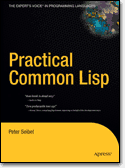


that book is dead sexy —Xach on #lisp
This page, and the pages it links to, contain text of the Common Lisp book Practical Common Lisp published by Apress These pages now contain the final text as it appears in the book. If you find errors in these pages, please send email to book@gigamonkeys.com. These pages will remain online in perpetuity—I hope they will serve as a useful introduction to Common Lisp for folks who are curious about Lisp but maybe not yet curious enough to shell out big bucks for a dead-tree book and a good Common Lisp tutorial for folks who want to get down to real coding right away. However, don't let that stop you from buying the printed version available from Apress at your favorite local or online bookseller. For the complete bookstore browsing experience, you can read the letter to the reader that appears on the back cover of the treeware edition of the book.
Coders at Work out!
My new book, Coders at Work, a collection of Q&A interviews with fifteen all-time great programmers and computer scientists, is out and available from Amazon, Barnes & Noble, Powell's, other fine booksellers near you and as an eBook from Apress.
Buy Practical Common Lisp now
Amazon | Powells | Barnes & Noble
Download source code: tar.gz | zip
Spread the word
Like what you've read? Then help spread the word. Recommend this book to your friends. Write a review on Amazon. Blog about it. Link to this page from your web site. Whatever. Apress took a chance, publishing this book when other publishers thought there was no market for a Lisp book. While it's unlikely that I'll get rich off my royalties, we don't have to sell all that many copies for Apress to turn a profit and show the naysayers that Lisp has legs yet.